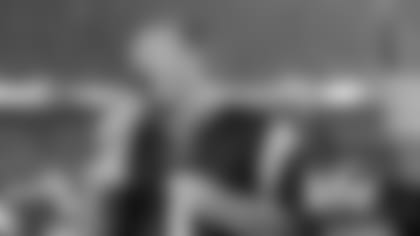BB: We're starting to wind down our preparations here this week. Today and tomorrow are review days. [We'll] work on some situations, tighten up some things in the kicking game, red area, goal line, short yardage, special situations, all those kind of things. I think we're moving along. Of course, we'll see where we're at Monday night.
Q: Players always say they have butterflies for the first game until they get out and make a play. When do the butterflies go away for coaches?
BB: I think once the game starts, kind of like the players said. After that first kickoff then you're into the game. There are a lot of things going into this game that you're not as sure about - your team, their team, all the matchups and all that. There's more of a comfort level when you have more evidence. But it's exciting. It's always exciting to get started.
Q: You've talked in the past about trying Matt Light at right tackle and it didn't work out - he was a left tackle. How has Nate Solder looked when you've tried him at right tackle?
BB: Good. I think Nate is a pretty versatile guy. [He] seems very flexible - athletically, his footwork and so forth. He seems to be very comfortable wherever we put him.
Q: What are the challenges for a player that flips sides?
BB: Different techniques, yes. Playing from inside-out and keeping your weight on your inside foot in pass protection or reach blocking, working with different people - the right guard instead of the left guard. Tight ends are tight ends; they flip sides, but working with different guys next to you in games and blocking combinations, things like that [are some of the challenges.]
Q: You mentioned earlier this week that the Dolphins are a big, physical line. Have you seen them make a concerted effort to improve in that area?
BB: That's the way it's been. They drafted [John] Jerry the year before. Jake Long - they drafted him three years ago, whatever it was. Offensively and defensively, they have some big, physical guys on both sides of the line. I think that's the way the team has been built and it looks like that's what they're going to continue to do. They add them every year - [Jared] Odrick last year.
Q: Do you get a sense that Sebastian Vollmer's injury is serious and of the long-term nature?
BB: However it is listed, that's what it is. Whatever he is able to do, we'll list him based on what he is able to do this week on the injury report on Saturday, I guess it is. As we have information, we'll give it to you.
Q: Have you ever carried only two active tackles? Is that something that is feasible?
BB: My guess would be if you went back and looked at our game day roster, most of the time we would have seven offensive linemen. I can't remember having six although it might have happened. Occasionally eight but seven to eight - I think that's pretty much what every team in the league would have - seven or eight. Probably more teams with seven than eight but it depends on each individual team.
Q: The theory was always that teams are right-handed offensively and there were bigger defensive ends on that side. Does it still hold true that that is the power side?
BB: I would say generally.
Q: How would you define the 'Patriot Way?'
BB: Right now our way is to try to find a way to beat Miami. That's really what we're about now. Trying to prepare well, trying to have everything tightened up, go down there confidently, go out there and play well. Hopefully that will result in a victory; that's what we're trying to do now.
Q: What kind of challenges does Vontae Davis present? Is he similar to Darrelle Revis in New York?
BB: Both [are] good perimeter corners. Vontae is fast, he's a very good athlete, he's big, he's got good size, he's physical, tackles well, good run-force player, good coverage player. I don't think he has too many limitations physically. He has been a good player for them for three years now.
Q: They have a bigger guy on the other side, Sean Smith, who is somewhat similar to Antonio Cromartie. Would you say the players are similar?
BB: I'd say their height and length, [yes]. There's not many corners - talk about corners over 6'2'', there's not many of them in the league. For them to be that tall, that makes them similar and it's a small group.
Q: What kind of leadership role has Matthew Slater shown on special teams?
BB: I think Matt has been the same guy on special teams as he's been on offense and even on defense when we had him on defense. He's a hard working kid, smart, really is one of the first guys in [and] last one to leave kind of guys. [He's] a well conditioned athlete that really prepares well and works hard and he gets better every week and get better every year. I think his game has improved steadily in the three-plus years he's been here.
Q: You said last year that there was no Larry Izzo role that is almost like an assistant special teams coach. Can you see Matthew Slater evolving in that area?
BB: I think the way that the team spoke their feelings for Slater is that [he] definitely represents a strong leadership role. Larry Izzo is in a pretty special category. I don't know that in all my years of coaching, I can't think of another player that I've ever been around that I would put up there with Larry in terms of what he did both on and off the field for the team relative to the kicking game - totally comprehensive, not one specific thing, but just combining everything that he did. That's a pretty big comparison now. He did it for a long time, too. You can evaluate some other guys at the end of their careers relative to what Larry did and I'm not sure exactly where Larry was, like in his fourth year - that was a long time ago, but he's pretty special. But [there're] no complaints on Matt. Matt's doing a great job for us.
Q: As Shaun Ellis and Andre Carter were getting acclimated, Jermaine Cunningham was out. Has he caught up to them and what does that picture look like for Monday night?
BB: Jermaine missed a little bit of time there in training camp. He's working his way back. He played a lot of football for us last year. We'll see how all that comes along. Unfortunately, he hasn't done a lot out there as much recently, but it's growing. He's doing more now so we'll see how it all plays out.
Q: You've had a couple days with Brian Waters. Can you talk about how he's coming in terms of acclimating?
BB: I think he's done a fine job. Very professional, he's got a lot of experience, so I don't think there's much that he hasn't seen. It's just a question of getting acclimated to our terminology and some of the ways the plays are called or the process or the system of it, as opposed to it being like something you've never done before. Just how you get from one play to another, what adjustments you make within a play against a certain look. Do you stay with the play? Do you change it? How do you adjust to it? Those things. He's a very experienced guy, he's a good athlete, he's strong. [I'm] glad we have him.
Q: Are you anticipating that Brian Waters will be available for Monday?
BB: We'll see.
Q: When Logan Mankins came back, I remember a rotation. Is that what you see happening with getting Brian Waters in there?
BB: We'll finish up through the week and see where things are at, see what the availability is of all the players, how we feel about them, where we feel like they are. If there are any limitations with Brian this week, maybe they won't be there next week; maybe they will. I don't know. We'll just have to wait and see.
Q: This will be the first time with a 46-man game day roster. How do you envision that unfolding in terms of the extra player? Are you leaning toward having another quarterback or the value of having a player in another position that could help you, let's say, on fourth down?
BB: I think that's really the discussion. You look at the players that are available, so it's 53 minus whichever players aren't able to participate in the game - medically, physically aren't ready - so whatever you get that number down to, and then with those players you take the 46 that you feel are best for that particular game. It definitely can change from week-to-week as circumstances change, depending on your game plan, your opponent, the health of your players and so forth. I can see that going different ways for us and really for a lot of different teams. Just talking to other coaches about it, I think it's just a weekly decision you make for your team based on that particular game. Next week is next week and you reevaluate it then.
Q: How does the limitation on padded practices impact you and the coaching staff in terms of preparation? There's been a lot of talk about that.
BB: We'll that's good - you guys can talk about it all you want. Whatever they are, they are and that's what we'll do. Our opportunities to practice and what we're allowed to wear in practice, those are what they are and we'll try to make the most of those.
Q: I read a comment from Dolphins Head Coach Tony Sparano about the unknown of their offense. That's a team with the Wildcat that you guys saw. How do you prepare for that unknown and does that make in-game coaching more important this week?
BB: I think the players and coaches' adjustments to anything new, of course that's part of every game. They ran a lot of it [the Wildcat] in the past. [Offensive Coordinator] Brian [Daboll] ran it in Cleveland with [Josh] Cribbs and we saw it over the last couple of years. We prepared for it, I think, literally every week. We'll prepare for it this week, we'll prepare for it next week, even if a team hasn't shown it. It's not that far-fetched, you know, because so many teams have run it anyway. We discuss what our adjustments are going to be to it, how we're going to play it, and then if that's okay, then great and if something happens and we need to adjust it, then we'll adjust it during the game. I'm just saying things like that, like unbalanced line, empty formations, Wildcat formations, defensively four-man line, three-man line with some fourth guy floating around back there behind the line of scrimmage, five defensive backs, six defensive backs, whichever they have shown, I think you still have to be ready and know what to do if they do any of the other things, you know, play a five-down look, cover the offensive lineman with somebody whether it's a defensive lineman or a linebacker walk-up - what we call the diamond front or the old Bear defense, that kind of thing. Those are pretty - I won't say they're standard - but things you better be ready for. If you don't see it this week, you're going to see it next week, if you don't see it next week, you'll see it the week after that. It's not that uncommon.
Q: Can you talk about carrying a third quarterback? In terms of your roster, for someone like Ryan Mallett, how do you keep him involved and prepared?
BB: All of our quarterbacks pretty much go through the same game preparation in terms of meetings, film [and] game plan. They all take a certain number of reps in our walk through. The player who goes first gets the most and the player who goes second gets the second most and the third guy gets the least. And then we split those reps up also with when the offense is working for the defense and so they get their practice opportunities there and after practice they stay after and work with different receivers, tight ends, backs, whatever it is in that aspect of the passing game, timing, routes and so forth. There're plenty of throwing opportunities for all three quarterbacks. There're only so many opportunities to actually take a snap from center in a team setting, but I think that all three guys should be able to learn, just like any other position, something about their play when the other person is doing it and they're there watching it: looking at the reads, looking at the checks or the pre-snap reads, the decision with the ball and so forth. I think that's how you develop as a player. Whether you're in there or not, you still gain that experience if you're paying attention and listening to what's going on, no matter which place you are on the depth chart.







































